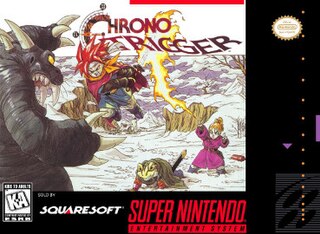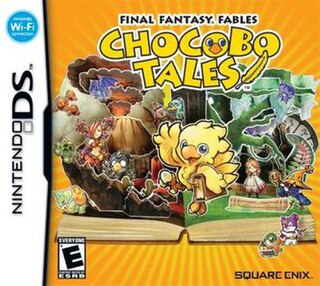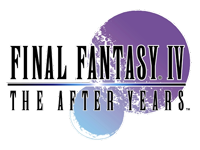
Chrono Trigger is a 1995 role-playing video game developed and published by Square. It was originally released for the Super Nintendo Entertainment System as the first entry in the Chrono series. The game's development team included three designers that Square dubbed the "Dream Team": Hironobu Sakaguchi, creator of Square's Final Fantasy series; Yuji Horii, creator of Enix's Dragon Quest series; and Akira Toriyama, character designer of Dragon Quest and author of the Dragon Ball manga series. In addition, Takashi Tokita co-directed the game and co-wrote the scenario, Kazuhiko Aoki produced the game, while Masato Kato wrote most of the story. The game's plot follows a group of adventurers who travel through time to prevent a global catastrophe.

Final Fantasy IV, titled Final Fantasy II in its initial North American release, is a role-playing video game developed and published by Square for the Super Nintendo Entertainment System. Released in 1991, it is the fourth main installment of the Final Fantasy series. The game's story follows Cecil, a dark knight, as he tries to prevent the sorcerer Golbez from seizing powerful crystals and destroying the world. He is joined on this quest by a frequently changing group of allies. Final Fantasy IV introduced innovations that became staples of the Final Fantasy series and role-playing games in general. Its "Active Time Battle" system was used in five subsequent Final Fantasy games, and unlike prior games in the series, IV gave each character their own unchangeable character class — although at a few points in the story, a dark knight will choose the path of a paladin, or a summoner will evolve to a new tier of spellcasting.

Final Fantasy Chronicles is a compilation of Square's role-playing video games Final Fantasy IV (1991) and Chrono Trigger (1995), released for the North American Sony PlayStation on July 2, 2001. TOSE ported both titles from the Super Nintendo Entertainment System; each had been previously released as individual Japanese PlayStation ports in 1997 and 1999. Several bonus features were added to each game, such as art galleries, bestiaries, and cutscenes—including computer-generated imagery full motion video used at the beginning of Final Fantasy IV and anime scenes used throughout Chrono Trigger.

Final Fantasy V is a fantasy role-playing video game developed and published by Square in 1992. It is the fifth main installment of the Final Fantasy series. The game first appeared only in Japan on Nintendo's Super Famicom. It has been ported with minor differences to Sony's PlayStation and Nintendo's Game Boy Advance. An original video animation produced in 1994 called Final Fantasy: Legend of the Crystals serves as a sequel to the events depicted in the game. It was released for the PlayStation Network on April 6, 2011, in Japan. An enhanced port of the game, with new high-resolution graphics and a touch-based interface, was released for iPhone and iPad on March 28, 2013, for Android on September 25 the same year and for Windows on September 24, 2015. A more enhanced re-release of the game as part of the Final Fantasy Pixel Remaster series, was released on November 10, 2021 for Android, iOS, and Windows, and for Nintendo Switch and PlayStation 4 on April 19, 2023.

Final Fantasy III is a role-playing video game developed and published by Square for the Family Computer. The third installment in the Final Fantasy series, it is the first numbered Final Fantasy game to feature the job-change system. The story revolves around four orphaned youths drawn to a crystal of light. The crystal grants them some of its power, and instructs them to go forth and restore balance to the world. Not knowing what to make of the crystal's pronouncements, but nonetheless recognizing the importance of its words, the four inform their adoptive families of their mission and set out to explore and bring back balance to the world.

Itadaki Street is a party video game series originally created by Dragon Quest designer Yuji Horii. It is currently owned by Square Enix. The first game was released in Japan on Nintendo's Famicom console in 1991. Since then, new installments in the series have been released for the Super Famicom, PlayStation, PlayStation 2, PlayStation Portable, Nintendo DS, Mobile Phones, Android, iOS, PlayStation 4 and PlayStation Vita. The series was exclusive to Japan prior to the 2011 Itadaki Street Wii, which is released as Fortune Street in North America and Boom Street in Europe.

Dragon Quest IV: Chapters of the Chosen, titled Dragon Warrior IV when initially localized to North America, is a role-playing video game, the fourth installment of the Dragon Quest video game series developed by Chunsoft and published by Enix, and the first of the Zenithian Trilogy. It was originally released for the Famicom on 11 February 1990 in Japan. A North American NES version followed in October 1992, and would be the last Dragon Quest game localized and published by Enix's Enix America Corporation subsidiary prior to its closure in November 1995, as well as the last Dragon Quest game to be localized into English prior to the localization of Dragon Warrior Monsters in December 1999. The game was remade by Heartbeat for the PlayStation, which eventually was available as an Ultimate Hits game. The remake was ported by ArtePiazza to the Nintendo DS, released in Japan November 2007 and worldwide in September 2008. A mobile version based on the Nintendo DS remake was released in 2014 for Android and iOS.

Live A Live is a 1994 role-playing video game developed and published by Square for the Super Famicom. A remake was published by Square Enix in Japan and Nintendo worldwide, releasing first for Nintendo Switch in 2022, and the following year for PlayStation 4, PlayStation 5, and Windows. The game follows seven distinct scenarios scattered across different time periods, with two more unlockable scenarios linking the narratives together through the recurring antagonist Odio. Gameplay is split between exploration with story-specific twists, and turn-based combat played out on a grid.

Final Fantasy Legend II, known in Japan as SaGa 2: Hihou Densetsu, is a role-playing video game developed and published by Square for the Game Boy. The second entry in the SaGa series, it was released in 1990 in Japan, and in 1991 in North America. A remake for the Nintendo DS was released in 2009 by Square Enix, remaining exclusive to Japan. The Game Boy version was later ported to the Nintendo Switch and released worldwide by Square Enix in 2020, with later ports to Android, iOS and Microsoft Windows in 2021.

Final Fantasy IV, a role-playing video game released by Square in 1991, revolves around Cecil Harvey, a knight of Baron who embarks on a quest to defeat Golbez, a man that is controlling the king of Baron. During Cecil's quest, he is joined by his childhood friends Kain Highwind and Rosa Farrell, as well as other warriors from around the world who also seek to stop Golbez. The visuals of the characters were designed by Yoshitaka Amano. After its initial release, Final Fantasy IV was later ported to multiple consoles. In 2007, Square Enix released an enhanced remake for the Nintendo DS that added voice acting to both the Japanese and English versions.
The Chrono series is a video game franchise developed and published by Square, and is currently owned by Square Enix. The series began in 1995 with the time travel role-playing video game Chrono Trigger, which spawned two continuations, Radical Dreamers: Nusumenai Hōseki, and Chrono Cross. A promotional anime called Dimensional Adventure Numa Monjar and two ports of Chrono Trigger were also produced. As of March 31, 2003, Chrono Trigger was Square Enix's 12th best-selling game, with 2.65 million units shipped. Chrono Cross was the 24th, with 1.5 million units shipped. By 2019, the two games had sold over 5.5 million units combined. The games in the series have been called some of the greatest of all time, with most of the praise going towards Chrono Trigger. The series' original soundtracks, composed by Yasunori Mitsuda, have also been praised, with multiple soundtracks being released for them.

Final Fantasy Fables: Chocobo Tales, released in Japan as Chocobo to Mahō no Ehon is a Nintendo DS adventure game developed by h.a.n.d. and published by Square Enix. It was released in Japan on December 14, 2006, in North America on April 3, 2007, and in the PAL region in May.

The World Ends with You is an action role-playing game co-developed by Square Enix and Jupiter for the Nintendo DS. Set in the modern-day Shibuya shopping district of Tokyo, The World Ends with You features a distinctive art style and urban fantasy elements inspired by Shibuya and its youth culture. Development was inspired by elements of Jupiter's previous handheld game, Kingdom Hearts: Chain of Memories. It was released in Japan in July 2007, and in PAL regions and North America in April 2008. Later, an enhanced port by h.a.n.d. for mobile devices was released in 2012 under the title The World Ends with You: Solo Remix, while another enhanced port for the Nintendo Switch was released worldwide in 2018 under the title The World Ends with You: Final Remix.
Takashi Tokita is a Japanese video game developer working for Square Enix. He has worked there since 1985, and has worked as the lead designer for Final Fantasy IV as well as the director of Live A Live, Parasite Eve and Chrono Trigger.

Final Fantasy Fables: Chocobo's Dungeon is a 2007 role-playing video game published by Square Enix for the Wii. It is an installment in the Chocobo series that focuses on Chocobo and his quest to free a town lost in time from eternal forgetfulness. It is a loose sequel to Chocobo's Dungeon 2 on the PlayStation.

Kingdom Hearts Coded is an episodic action role-playing puzzle video game developed and published by Square Enix, in collaboration with Disney Interactive Studios, for mobile phones. Coded was a Japan-only release announced at the 2007 Tokyo Game Show. Its Nintendo DS remake titled Kingdom Hearts Re:coded was released in Japan, North America, Europe, and Australia. A cinematic remake of the game was included in the Kingdom Hearts HD 2.5 Remix video game compilation for the PlayStation 3, PlayStation 4, Xbox One, Windows, and Nintendo Switch.

Final Fantasy IV: The After Years is an episodic role-playing video game co-developed by Matrix Software and Square Enix, as the sequel to the 1991 title Final Fantasy IV. Set 17 years after Final Fantasy IV, The After Years follows the original cast and their descendants in episodic tales as a new villain appears, setting into action a mysterious chain of events that threatens the fate of the Blue Planet. Largely utilizing assets, locations, and mechanics from its predecessor, the title incorporates higher quality character graphics and several new gameplay systems.

Final Fantasy is a fantasy role-playing video game developed and published by Square in 1987. It is the first game in Square's Final Fantasy series, created by Hironobu Sakaguchi. Originally released for the NES, Final Fantasy was remade for several video game consoles and is frequently packaged with Final Fantasy II in video game collections. The first Final Fantasy story follows four youths called the Warriors of Light, who each carry one of their world's four elemental crystals which have been darkened by the four Elemental Fiends. Together, they quest to defeat these evil forces, restore light to the crystals, and save their world.
Tetsuya Nomura is a Japanese video game artist, designer, producer, and director working for Square Enix. He was hired by Square initially as a monster designer for Final Fantasy V (1992), before being shifted towards secondary character designer alongside Yoshitaka Amano for Final Fantasy VI (1994). Final Fantasy VII (1997) had him working in the original story alongside Hironobu Sakaguchi, and marked his debut as the lead character designer, a capacity he would retain for several future installments of the series, as well as other Square Enix titles such as The Bouncer and The World Ends with You.

Final Fantasy III is a Nintendo DS role-playing video game and a remake of the 1990 Family Computer game, Final Fantasy III.



















